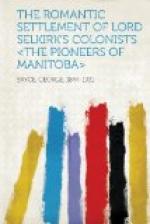East face in 1882, when
fort was dismantled (From
painting in author’s possession.)
x Spot where Scott was Executed.]
CHAPTER XVIII.
The ogre of justice.
The wild life of the prairie or mountain cultivates a spirit of freedom. When individuals must become a law unto themselves, when the absence of steamers, railways, electric power, work-shops, and mills, throws men on their own resources, they find it irksome to obey the law. They regard its restrictions as tyrannical. The prairie horse becomes free. He must be caught with the lasso, he needs to be hobbled near the camp, it is necessary to curb him in his temper, but in his wild state he can provide for himself. He knows the best pasture and seeks it, he is acquainted with the water courses and finds them, he returns or not to his stable or covert at his own sweet will, he fights the wolf or the bear and protects the colts from the wild beasts.
As is the prairie steed, so to a large extent is his master. He is apt to despise civilization, prefers his buckskin coat and fringed leggings, and loves the moccasin rather than the stiff leather shoe.
With him the idea of sub-division of property is not developed. There are no local game laws. He shoots large or small game, moose or prairie chicken, whenever he can find them. He traps on whatever stream he chooses. His idea of personal property is very liberal. He is large-hearted and bountiful, divides his find of game with his neighbors, and his shanty has, as he says, “a latch hanging outside the door,” for any wanderer or passing stranger.
This many-sided notion of freedom belongs to all primitive peoples and societies. Of the Red River Community the French half-breed was of the most unsubdued and restive type, for he followed the ways of the Indians, while the Selkirk Colonists and their descendants always professed to be farmers, and hunting was only their diversion. Moreover, being of Scottish blood, they had been taught to fear God and honor the King.
We have seen that Governor Simpson had a plan in his mind for gaining control and preserving order in his own kingdom. His idea of building fortified stone forts is chiefly seen in the cases of Upper and Lower Forts Garry. Fort Garry was, as we have seen, well on the way to completion by the time of the French outbreak in connection with Larocque. And Governor Christie was authorized to go on and construct a still more elaborate fort at the Forks to replace the wooden Fort Garry built shortly after the union of the Companies. Thus, a large Fort with numerous buildings, suitable for trade and residence, was begun in 1835, and around it a substantial stone wall was built. The dimensions from east to west were 280 feet, and from north to south 240 feet. The fort faced the Assiniboine




